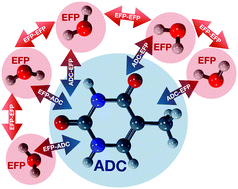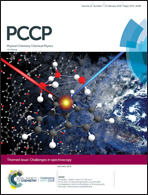Algebraic diagrammatic construction for the polarisation propagator in combination with effective fragment potentials†
Abstract
The effective fragment potential (EFP) method for the efficient inclusion of solvation effects is combined with the algebraic diagrammatic construction (ADC) scheme for the second- and third-order polarisation propagator. The accuracy of these newly developed EFP-ADC(2) and EFP-ADC(3) methods is tested with respect to supermolecular ADC calculations for a selected set of small solute·solvent complexes. The EFP model for solvation introduces only marginal errors in the excitation energies and oscillator strengths of singlet as well as triplet states, which are strictly localized on the chromophore, significantly below the intrinsic errors of the parent ADC(2) and ADC(3) methods. It is only when delocalization of electron density on the solvent molecules occurs that the error in the excitation energies increases, a well-known behavior of environment models in general. Overall, EFP-ADC schemes prove to be reliable computational approaches to simulate electronic absorption spectra in solution.

- This article is part of the themed collection: Challenges in spectroscopy: accuracy vs interpretation from isolated molecules to condensed phases


 Please wait while we load your content...
Please wait while we load your content...